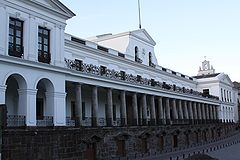Carondelet Palace
| Carondelet Palace | |
|---|---|
| Palacio de Carondelet (Spanish) | |
 |
|
| General information | |
| Type | Palace |
| Architectural style | Spanish baroque |
| Location | Quito, Ecuador |
| Address | García Moreno St. and Chile Rd. |
| Coordinates | 0°13′11″S 78°30′45″W / 0.21972°S 78.51250°W |
| Elevation | 2,820 m (9,252 ft) |
| Current tenants | President of Ecuador |
| Construction started | 1801 |
| Client | Barón Francisco Luis Héctor de Carondelet |
| Owner | Ecuadorian government |
Carondelet Palace (Spanish: Palacio de Carondelet) is the seat of government of the Republic of Ecuador, located in Quito. Access is by the public space known as Independence Square or Plaza Grande (colloquial name), around which are also the Archbishop's Palace, Municipal Palace, Hotel Plaza Grande, and Metropolitan Cathedral.
The history of this emblematic building dates back to colonial times, around 1570, with the acquisition of the former royal houses located in the city of Quito.
The first seat of the Spanish Crown in the Royal Audience of Quito functioned near the convent of La Merced (current Cuenca and Chile streets) until around the year 1611, when dies Diego Suarez de Figueroa, secretary of the audience, who owned a small palace built in the central square (Plaza Grande).
Juan Fernandez de Recalde, president of the Audience then informed the king that the building was finished, and it was purchased by the Crown as a larger building to house the comfortable premises of the Spanish Administration in Quito soil.
Some time later, the successor to President Recalde, Antonio de Morga, informed the king that the royal houses were unworthy to carry that name, because they were close and very old, so they proposed to buy the adjacent houses. The earthquake of 1627 forced them to buy the neighboring buildings that, because of their age, were rebuilt in stone and brick. Thereafter, the power of the audience settled in front of the Plaza Grande.
In 1799, the Barón Francisco Luis Héctor de Carondelet was appointed chairman of the hearing. In 1801, the Spanish engaged to Antonio Garcia, under his direction, perform work of rehabilitation and improvements, both at the Palace of the audience at the Cathedral as well; also led the work on the arches of the sewers and the renovation of the Prison building.
After the independence of Ecuador culminated with the Battle of Pichincha in 1822, the palace became the headquarters of the South Department of Gran Colombia, receiving the liberator Simón Bolívar sometimes, who wondered at the elegance and austerity of the building in addition to being delighted with the taste of the Baron of Carondelet (main thrust of the work); thus, Bolivar gave the building the name of Carondelet Palace.
...
Wikipedia
